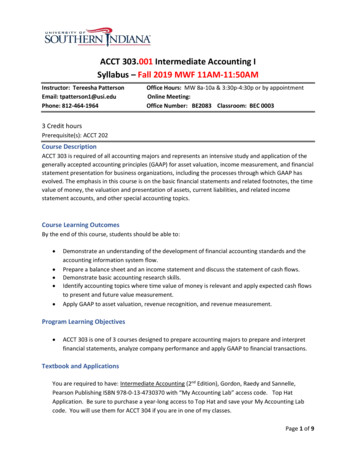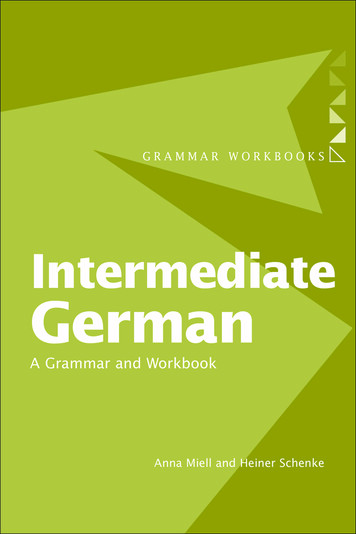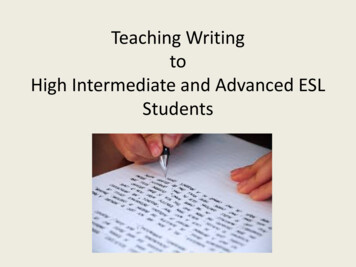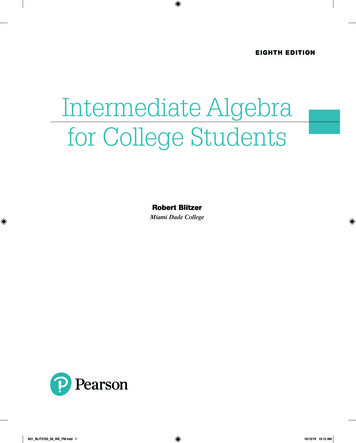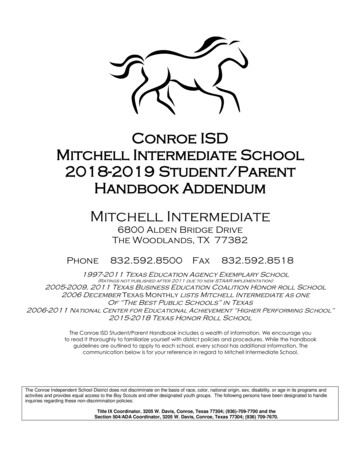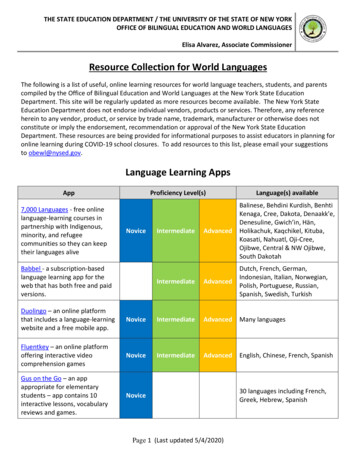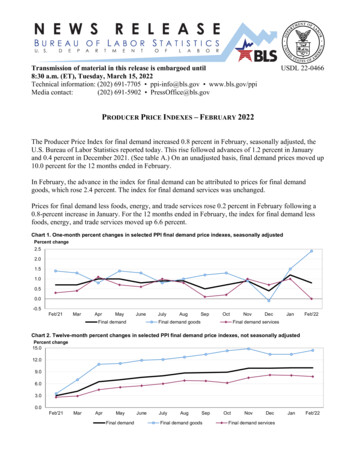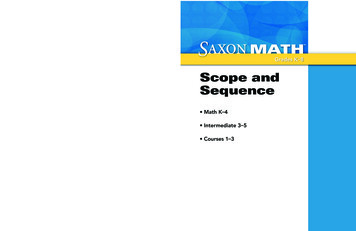
Transcription
Brad EdwardsFree sample pages from TheIntermediate TrombonistBuilding Blocksfor Tone and Technique 2018, Brad Edwards, All rights reservedFree sample pages - The Intermediate Trombonist
ForewordMy students and I love beginning a new lesson book. It’s a adventure similar tobeginning a new school year. Starting The Intermediate Trombonist means thatyou’re in a very special place in your trombone playing. No longer a beginner, youare ready to make a big jump forward in your skills and musical understanding.You’ll love getting better!There’s a lot about The Intermediate Trombonist that teachers will love, also.This book — like all of Brad Edwards’ books — is well organized and logical. Newinformation is presented in an appropriate order with excellent instructions.Lesson plans will help you know exactly how to organize the exercises throughoutthe book into 40 progressive lessons.Many older intermediate books — written before any of us were born — containinstructions that are outdated. Fortunately, not so with Dr. Edwards’ book. Also,unlike many older methods, The Intermediate Trombonist includes exercises thatare tuneful and interesting.The Intermediate Trombonist — along with an excellent instructor, a metronome,a tuner, and a way to record yourself — will be a perfect way to move your tromboneplaying forward to an exciting new level.Joe DixonSan Antonio, TexasJoe Dixon is a nationally recognized trombone clinician and a recipientof the 2018 Foundation Award from The Foundation for Music Education.AcknowledgementsI would like to thank the people who generously gave of their time and expertiseto provide input on early versions of this book. Although I have a few youngerstudents, I wanted to have some ‘extra pairs of eyes’ from other teachers to makesure I wasn’t going off course. To that end, my heartfelt thanks go to Sean Reusch,Brian Conklin, Rebecca Ford, Linda Landis and Joe Dixon for their suggestions.Thank you also to Julia Broome-Robinson for her proof-reading efforts andthoughtful input.Great credit goes to my wife, Martha. In fact, this book was her idea! She is sopatient being a ‘book widow’ during these time-consuming obsessions; for this I amtruly grateful.The photo credit goes to my daughter, Amelia. The sunset picture was taken inthe summer of 2016 along the Oregon coastline; a beautiful day!Free sample pages - The Intermediate Trombonist
About This BookThe Intermediate Trombonist is designed to fill a void that exists betweenbeginning books and more advanced materials. Duet parts for 100 of these etudesare available separately from TromboneZone.org.Daily 6-Minute Warm-UpMouthpiece buzzing, tone and positions, lip slurs, rhythmic articulation.Part One: Lip Slurs (20 exercises)Lip slurs are essential to embouchure development as well as overall technique.This sequence helps students progress smoothly from easy slurs to moreadvanced material.Part Two: Pattern-Building (40 exercises)This section explains such fundamentals of music theory as half steps andwhole steps in addition to providing scale practice. Many exercises present thesame patterns in both familiar and foreign keys.Part Three: Lyrical Legato (40 etudes, duet parts available)These little etudes help students develop a smooth, singing style. Extraexercises go into detail concerning the use of the legato tongue and natural slurs.Part Four: Varied Articulation (40 etudes, duet parts available)These provide practice with some subtleties of articulation including accent,staccato, tenuto, and mixing in legato tonguing as well as natural slurs.Part Five: Simple Tunes in Multiple Keys(20 tunes, duet parts available)These enjoyable little melodies presented in different keys help studentsdevelop ‘key sense’: that ability to think beyond slide positions to anunderstanding of how to transpose interval content into a foreign key.Appendices#1: The Overtone Series and Intonation#2: Developing the High Range#3: Introducing the Tenor Clef#4: Working with the F-attachment#5: More About Tuning#6: 22 Tips to Get Better#7: 10 Practice Tricks that WorkThis book cannot replace a private instructor.Find a good teacher and approach your lessonswith a teachable spirit!Free sample pages - The Intermediate Trombonist
Table of ContentsDaily 6-Minute Warm-Up . 1Part One: Lip Slurs . 7Part Two: Pattern-Building . 23Part Three: Lyrical Legato . 43Part Four: Varied Articulation .67Part Five: Simple Tunes in Multiple Keys. 95Appendix 1: The Overtone Series and Tuning .109Appendix 2: Developing the High Range . 112Appendix 3: Introducing the Tenor Clef . 116Appendix 4: Working with the F-attachment . 118Appendix 5: More About Tuning . 121Appendix 6: 22 Tips to Get Better . 128Appendix 7: 10 Practice Tricks that Work . 131DetailsPattern-BuildingHalf steps (H) and whole steps (W). 23Major scales and tetrachords . 23Accidentals. 24Whole steps above . 24Half steps below . 25Whole steps above and half steps below . 25Extra practice with slide accuracy . 26Tetrachords (using accidentals) . 27Flipping key signatures with tetrachords . 28More practice with slide accuracy . 30Flipping key signatures with "5 1" patterns .31One-octave major scales with melodic variations. 34The different forms of the minor scale . 38Flipping key signatures with minor scales . 39Free sample pages - The Intermediate Trombonist
Lyrical LegatoMini-Exercise: Blowing Air, then Buzzing on the Mouthpiece . 43Mini-Exercise: Constant Air and Precise Slide Timing in Legato . 44Natural slurs . 45Mixing legato tongue and natural slurs . 45Tuning the 6th partial . 46Mini-Exercise: D in Alternate 4th Position . 47Mini-Exercise: Using Quick Glisses to Improve Legato . 48Two pieces in A-flat major . 49Mini-Exercise: 6/8 "in 6" . 50Three pieces in G major . 52Two pieces with some syncopation . 54Mini-Exercise: Cut Time . 55Two pieces in cut time . 55What? 5/4 time?!? . 56Two pieces in D major . 57Introducing grace notes . 57Two pieces in A major . 58Mini-Exercise: 6/8 "In 2" . 59Two pieces using 6/8 “In 2” . 59Four pieces in minor keys . 62Exploring a few higher notes . 64Varied ArticulationMini-Exercise: Blowing and Playing . 67Mini-Exercise: Accents. 68Mini-Exercise: Staccato and Tenuto . 69Mini-Exercise: Including Natural Slurs. 70Mini-Exercise: Including Legato Tonguing . 71Mini-Exercise: Including Natural Slurs and Legato Tonguing . 72Mini-Exercise: Triplet Slur Grouping . 74Mini-Exercise: Some Basic 16th-Note Rhythms . 76Mini-Exercise: Some Dotted 16th-Note Rhythms . 78Mini-Exercise: Syncopation . 79Mini-Exercise: Syncopation in 3/4 Time . 80What? 3/2 time?!? . 82Two pieces in D major . 83Two pieces in A major . 84Mini-Exercise: 6/8 played "In 2" . 85What? 9/8 time?!? . 86Mini-Exercise: Dotted Rhythms in 6/8 Time . 88Mini-Exercise: Sextuplets . 90Three pieces in odd meters.91What? Changing time signatures?!? . 92Exploring a few higher notes . 93Simple TunesMini-Exercise: "D.C. al Fine" . 96Free sample pages - The Intermediate Trombonist
Plan of Study (with page numbers)Unit tionSimpleTunes1#1 (7)#1 Whole stepsabove (24)#1 B-flat[Blow/Buzz] (43)#1 E-flat / F(Blow/Play) (67)#1a Come Thou (95)2#1 (7)#2 Half steps below(25)#2 F/B-flat(Slide Timing) (44)#2 E-flat(Accents) (68)#1b Come Thou (95)3#2 (8)#3 Whole / HalfSteps (25)#3 E-flat/B-flat(Natural Slurs) (45)#3 B-flat (Tenuto/Staccato) (69)#2a Old Paint (96)4#2 (8)#4 Whole / HalfSteps (26)#4 F/B-flat(Legato Tongue/Natural Slurs) (45)#4 F (Mixing innatural slurs) (70)#2b Old Paint (96)5#3 (9)#5 Slide accuracy(26)#5 E-flat(Legato tongue/Natural Slurs) (46)#5 E-flat(Including legatotonguing) (71)#3a Ash Grove (97)6#3 (9)#6 Tetrachords(27)#6 F (D in 4th) (47)#6 F (Natural slurslegato tonguing) (72)#3b Ash Grove (97)7#4 (9)#7 E-flat/E (28)#7 C (47)#7 C (73)#4a Barbara Allen (97)8#4 (9)#8 F/F-sharp (28)#8 C (48)#8 F (73)#4b Barbara Allen (97)9#5 (10)#9 G/G-flat (29)#9 C (triplets) (49)#9 E-flat (Triplet slurgroups) (74)#5a Smokey (98)10#5 (10)#10 A-flat/A (29)#10 A-flat (49)#10 A-flat (75)#5b Smokey (98)11#6 (10)#11 B-flat/B (29)#11 A-flat (50)#11 C (75)#6a Dreamer (98)12#6 (10)#12 D/D-flat (30)#12 F(6/8 in 6) (51)#12 A-flat(16th notes) (76)#6b Dreamer (99)13#7 (11)#13 C/C-flat (30)#13 B-flat(6/8 in 6) (52)#13 E-flat (16th notes)(77)#7a Pat-Pan (99)14#7 (11)#14 Slide acc. (30)#14 G (52)#14 G (16ths) (77)#7b Pat-Pan (99)15#8 (11)#15 E-flat/E (31)#15 G (53)#15 F (Dotted) (78)#8a Trumpet Tune (100)16#8 (11)#16 F/F-sharp (31)#16 G (6/8) (53)#16 G (Dotted) (79)#8b Trumpet Tune (100)17#9 (12)#17 G/G-flat (32)#17 F(Syncopation) (54)#17 B-flat(Syncopation) (80)#9a Gardens (100)18#9 (12)#18 A-flat/A (32)#18 E-flat(Syncopation) (54)#18 G (Syncopation)(80)#9b Gardens (100)19#10 (12)#19 B-flat/B (33)#19 A-flat/C(16th notes) (55)#19 A-flat(Syncopation) (81)#10a Jamaican (101)20#10 (12)#20 C/C-flat (33)#20 B-flat(Cut time) (55)#20 C (Cut time) (81)#10b Jamaican (101)
Unit LipSlursPatternBuildingLyrical LegatoVariedArticulationSimpleTunes21#11 (13)#21 C (34)#21 E-flat(Cut time) (56)#21 F (2/2) (82)#11a Rondeau (102)22#11 (13)#22 F (34)#22 F (5/4) (56)#22 B-flat (3/2) (82)#11b Rondeau (102)23#12 (14)#23 B-flat (34)#23 D (57)#23 D (83)#12a Stars & Stripes (103)24#12 (14)#24 E-flat (35)#24 D (Gracenotes) (57)#24 D (83)#12b Stars & Stripes (103)25#13 (15)#25 A-flat (35)#25 A (58)#25 A (6/8, 3/4) (84)#13a Blue Bells (104)26#13 (15)#26 D-flat (35)#26 A (58)#26 A (16ths) (84)#13b Blue Bells (104)27#14 (16)#27 G-flat (36)#27 E-flat(6/8 in 2) (59)#27 B-flat(6/8 in 2) (85)#14a Dunderbeck (104)28#14 (16)#28 G (36)#28 F (6/8 in 2)(60)#28 E-flat(6/8 in 2) (86)#14b Dunderbeck (104)29#15 (17)#29 D (36)#29 F (16ths) (60)#29 E-flat (9/8) (87)#15a Liberty Bell (105)30#15 (17)#30 A (37)#30 G(16ths) (61)#30 G (16ths andsyncopation) (87)#15b Liberty Bell (105)31#16 (18)#31 E (37)#31 G (6/8) (61)#31 A-flat (16ths) (88)#16a Annie Laurie (105)32#16 (18)#32 B (37)#32 d minor (62)#32 E-flat (6/8dotted) (89)#16b Annie Laurie (105)33#17 (19)#33 F-sharp (38)#33 c minor (62)#33 F (Sextuplets)#17a Endearing (106)34#17 (19)#34 c/c-sharp (39)#34 f minor (63)#34 A-flat (6/8dotted) (90)#17b Endearing (106)35#18 (20)#35 d/d-sharp (39)#35 a minor (63)
Part Four: Varied Articulation(40 etudes, duet parts available) These provide practice with some subtleties of articulation including accent, staccato, tenuto, and mixing in legato tonguing as well as natural slurs. Part Five: Simple Tunes in Multiple Keys. (20 tunes, duet parts available)


